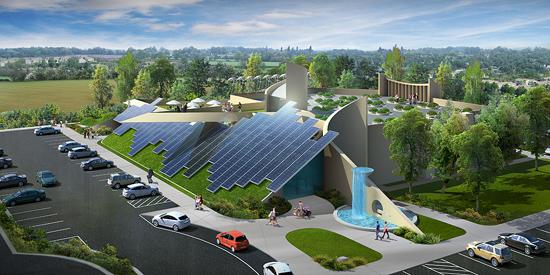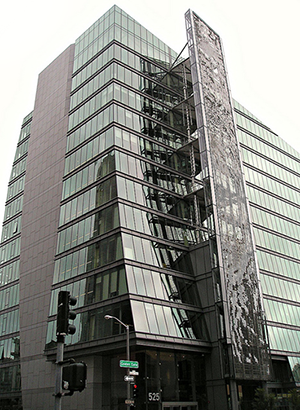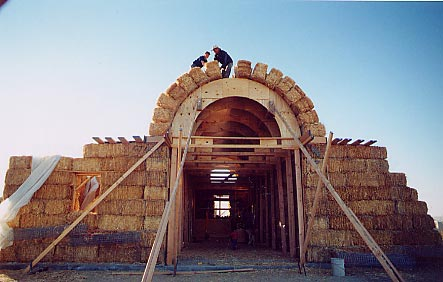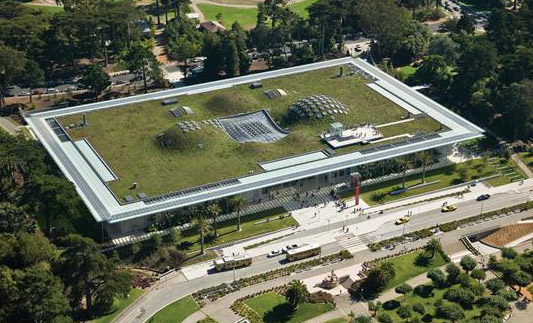Online courses start Monday, September 30, 2013. (See discount deadline date below.)
All instruction will be through distance learning. All courses consist of readings, and many include downloadable video and slide presentations by world-class experts.
Fall online courses include architecture, green building and sustainable design, and green project management.
Each course will require about one hour per week for instruction and one to two hours per week for course work.
You can earn up to 3 units of academic credit or up to 18 units continuing education units for each course. Tuition will be based on the level of your course work feedback. (See enrollment form below.)
You can extend our semester schedule of six weeks if you need more time to finish.
Students will be encouraged to meet online to discuss work and exchange notes on their learning experiences.

California Conservation Corp. building by SFIA MArch graduate, Arthur Dyson.
ENROLLMENT OPTIONS FOR TUITION AND ACADEMIC CREDIT
OPTION 1:
Certificate of Achievement and 1 unit of academic credit or 6 units of continuing education credit for successful completion and summary documentation of course materials. $100 tuition through September 27; $200 after that date. (If enrolling after September 30, please inquire.)
Academic units will be documented on your transcript and will count toward diplomas in any of our architecture and ecological design degree programs.
OPTION 2:
Certificate of Achievement and 2 units of academic credit or 12 units of continuing education credit. Requires several tell-back assignments to convey full involvement and understanding of the course materials. $200 tuition through September 27; $300 after that date. (If enrolling after September 30, please inquire.)
OPTION 3:
Certificate of Achievement and 3 units of academic credit or 18 units of continuing education credit. Includes faculty mentoring and requires tell-back assignments to convey understanding of course materials and a graphic or written thesis demonstrating your understanding of history, applications, and/or likely future advances in the subject matter of the course. $300 tuition through September 27; $400 after that date. (If enrolling after September 30, please inquire.)
Tuition and credit options 1 and 2 can be upgraded later at any time by completing the extended course work for review and submitting the required additional tuition fee.
To enroll, submit the enrollment form below.
NOTE:
These courses are selected from our distance learning degree programs and are being offered for the first time as stand-alone courses. You can earn Certificates of Achievement, up to 3 academic units or up to 18 continuing education units per course, and all units can be applied to any of our degree programs.

Wind energy system for San Francisco Public Utilities building by Reinhold Ziegler, SFIA instructor.
ARCHITECTURE COURSES
These are textbook-based courses, some of which also include emailed links to video and slide show presentations.
A 101
Creative Problem Solving
A series of excellent procedures for understanding and enhancing personal and professional creativity. Textbook: A Guide to Better Ideas, by James Adams.
A 104
Freehand Drawing and Sketching
Anyone can learn to draw, and the author of these textbooks has proven this for many years. Textbooks: The New Drawing on the Right Side of the Brain, by Betty Edwards and New Drawing on the Right Side of the Brain Workbook, by Betty Edwards.
A 203
Three-Dimensional Composition & Visualization
Architecture is a 3-D art form. The principles of composition and proportion are not difficult to master, and are very satisfying, once learned and applied. Textbook: Drawing and Designing with Confidence: A Step-by-Step Guide, by Mike W. Lin.
E 213
Buckminster Fuller’s Design & Construction Methods
This course provides insight into the thinking of one of the most creative and prolific architectural and engineering thinkers of the 20th century. Textbook: Bucky Works: Buckminster Fuller’s Ideas for Today, by J. Baldwin.

Strawbale construction by John Swearingen, SFIA alumnus and instructor.
GREEN BUILDING AND SUSTAINABLE DESIGN COURSES
These are textbook-based courses, some of which also include emailed links to video and slide show presentations.
E 201
Advanced Principles of Ecological Design
This course reviews the many technologies of ecological design and how to integrate them to get the best results.
E 206
Indoor Air Quality
When city indoor air pollution reaches levels six times that of outdoor pollution, we know we have a problem. This course deals with the problems and the solutions.
E 210
Underground & Earth-Sheltered Construction
This course shows a way to build that minimizes visual impact on the land, provides natural insulation and protection, and creates comfortable and economical environments.
E 212
Recycled Construction Materials
Recycling in construction is relatively new, and the theories and practices are still a work in progress. This course provides the best of the current state of the art, its implications for the future of materials manufacture, and materials use on the construction site.
MSGB 308
Toxic & Nontoxic Materials
This course examines how the toxicity of common chemicals in products as diverse as carpeting, computers, and cosmetics affects our health and how decreasing exposure to certain chemicals can improve health.
MSGB 310
Energy-Saving Retrofits
This course is an in-depth look into remodeling and retrofitting for energy-conservation needs and code requirements, covering all four major areas of retrofit: electrical, HVAC, architectural, and control. Included are proven methods for retrofitting glass, walls, roofs, floors, humidity control devices, lighting fixtures, motors, attic insulation, air handlers, sensors, and much more.

San Francisco Academy of Sciences. Green roof by Paul Kephart, SFIA instructor.
GREEN PROJECT MANAGEMENT COURSES
These courses are textbook-based only.
GPM 1
Principles and Best Practices of Project Management
Textbook: The Principles of Project Management, by Meri Williams.
GPM 4
Green Building Construction
Textbook: Contractors Guide to Green Building Construction: Management, Project Delivery, Documentation, and Risk Reduction, by Thomas E. Glavinich, Associated General Contractors.
GPM 5
Green Building Design and Delivery
Textbook: Sustainable Construction: Green Building Design and Delivery, by Charles J. Kibert.
GPM 7
Green Design and Project Management Strategies
Textbook: Emerald Architecture: Case Studies in Green Building, by “Greensource.”
San Francisco Institute of Architecture
Information Office
207 North Service Rd. East, Box 180
Ruston, LA 71270
1-800-634-7779
